Chapter 6 - Wave Theory and Electricity
Back to the Main Electricity Page
The universe was created by a concentrated energy swirl formation. The movement of energetic matter has already been described in the chapter on photons (see light stream).
In this chapter, I will discuss energetic matter using a more familiar name: electricity. Electricity is the movement of energetic matter via copper wires through rings (strings, paths, waves). Electricity is one way of transferring energetic matter. We do not know how to create energy, but we do know how to utilize it from nature and how to transfer it from place to place (picture below). Theoretically, we can derive energy from everything, as the entire universe is a formation of energetic matter. By further study, we can learn to utilize energy more efficiently. Although this seems simple, it is a very complex issue.

Energetic matter in wires and other formations streams at light speed; greater velocities, however, may occur in forms like vibrations or signals. Energy signals are transferred more rapidly than light. Changing an energy level at one point in an electric system immediately changes energy levels in all formations in its space.
In the following three pictures , we see that the energetic matter in wires flows around electrons along energetic and magnetic rings to its destination. The second and third pictures illustrate electric current in more detail.



The next picture illustrates the alternating electric current that is the basis of all computer functions.

Energy always circulates in a swirl formation that expands into lower energy levels. When we utilize energetic matter, we do not annihilate it; we change its swirl formations, energy level, space and time. Energy is space and space is energy. By concentrating energetic matter, we concentrate space and elevate the energetic level.
energetic matter |
= |
energetic level | ||
space |
Except for a brief theoretical discussion, I will not elaborate on the subject of electricity, as a great deal has already been written.
Static Electricity
Static electricity is defined as an electrostatic force that charges by
contact or induction. In wave theory, however, energetic matter is a living
creation, rotating and vibrating in closed formations. The beauty of living
energetic matter is that it appears in different patterns, moving in a
serpentine path in semi-closed rings that create different structures
and phases (picture below). The behaviour of energetic matter is the same
in all phases and formations, and applies in experiments with glass and
resin balls and metallic objects.
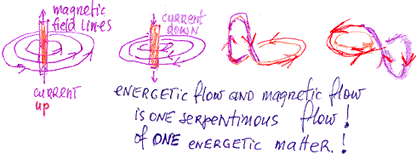
Every structure is composed of atoms in which basic energetic matter is in a state of continuous local circulation. The structure of the atom and its bonds allows energy to flow, while limiting its circulation to atoms or molecule formations (picture below featuring the molecula of two atoms). In metallic formations, molecules and the paths between them are well organized, allowing energy to flow in large spaces. The molecular bonds (paths) of rubber bands or ebonite, for example, are not suitable for the circulation of energy in large spaces.
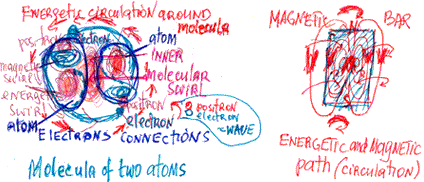
Energetic matter has no rigid borders, even in seemingly well-defined formations (see the chapters on the photon and the universe). It influences distant formations by its energetic space and circulate between them in a manner similar to the wave circulation of energetic matter. By rubbing ebonite, we add energy, align its paths and enlarge its space, enabling it to come in contact with objects that accept its excess energy (static electricity) (picture below).

A closed swirl (wave) cannot accept energy beyond its capacity (the common
energetic space of a closed circulation), but additional energy enlarges
van der Waals’ peripheral atom circulation energy spaces and energetic
paths. When we place two 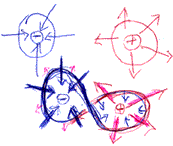 sweaters
together, their shared energetic space is larger than the sum of their
individual spaces. When separated, their energetic level (space) is diminished
and excess energy is expelled as visible sparks.
sweaters
together, their shared energetic space is larger than the sum of their
individual spaces. When separated, their energetic level (space) is diminished
and excess energy is expelled as visible sparks.
An electric charge creates an electric field in the surrounding space. Michael Faraday (1791 – 1867) proposed a map of electric field lines (lines of force). These are always directed away from a positive charge and toward a negative charge. Wave theory explains these forces (see picture to the right).
When an ebonite rod is rubbed against animal fur, the ebonite charge becomes negative and the fur charge becomes positive. Bringing the rod near a glass ball induces a positive charge on the side of the ball closest to the rod, and a negative charge on its far side - similar to the “plus” and “minus” loops of a wave formation (see picture to the right). This is not really a wave, however, as it was not created by a primary energy swirl, nor is it even a molecular formation. It is merely an energetic circulation relationship similar to a wave.
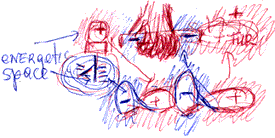
In addition, classic experiments with electroscopes demonstrate
very important properties of energetic matter-space (picture 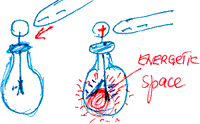 below).
Adding energetic matter causes the foil to be pushed away. The more energy
we add, the more the foil is pushed away. This simple, impressive experiment
demonstrates that energetic matter has its space. The greater the energetic
matter, the greater the space. Energetic matter = space and space
= energetic matter. In this picture, we clearly see that energetic
matter = space.
below).
Adding energetic matter causes the foil to be pushed away. The more energy
we add, the more the foil is pushed away. This simple, impressive experiment
demonstrates that energetic matter has its space. The greater the energetic
matter, the greater the space. Energetic matter = space and space
= energetic matter. In this picture, we clearly see that energetic
matter = space.
- end -
Back to Top
Dr. Chaim Tejman, Copyright© 2001. All rights reserved.